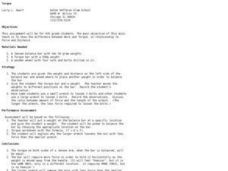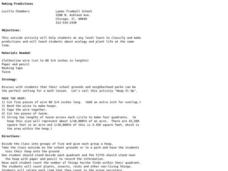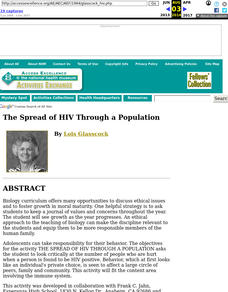Curated OER
The Difference Between Acids and Bases Using Different Indicators
Students identify the differences between acids and bases. In this acids and bases lesson plan, students identify and distinguish between acids and bases. They use household products to test the ph levels. They test the ph levels by...
Curated OER
Burning vs. Heating
Students investigate burning vs. heating and observe the differences. In this burning vs. heating lesson plan, students observe a wooden splint burning and a piece of glass tubing being heated. They answer questions to compare the two...
Curated OER
Osmosis
Students investigate osmosis and diffusion in a liquid environment. In this osmosis lesson plan, students use dialysis tubing made into bags and filled with 3 different solutions. They observe the movement of water molecules into higher...
Curated OER
How are torque and work different?
Sixth graders explore how torque and work are different. In this torque lesson, 6th graders will understand the relationship between torque and work as it applies to force and distance. Students will be assessed on their conclusions of...
Curated OER
Air Pressure
Students perform experiments that demonstrate the characteristics of air pressure. For this physics lesson, students participate and observe experiments using simple household items. The results of these experiments are used to help the...
Curated OER
Liquid Conductors
Students identify liquids as conductors. In this circuits lesson, students build a circuit, then use various liquids to complete the circuit, and determine which liquids successfully conduct electricity.
Curated OER
Making Predictions
Students collect and classify items. In this making predictions lesson plan, students go outside and collect specimens of plants, insects and minerals. They classify each item and place them in a Venn Diagram. Students compare and...
Curated OER
Light
Students explore light. In this light wave physics lesson, students construct periscopes, kaleidoscopes, color wheels, and pinhole cameras. Students observe and record characteristics of light demonstrated through the use of...
Curated OER
A Fish Tale
Students conduct an experiment. In this fish lesson, students discover how fish cells respond to fresh and salty water and if temperature effect the movement of a fish's gills. Students also identify the characteristics of a fish.
Curated OER
Using a Compass
Students determine how to shoot a bearing. In this compass and orienteering lesson, students review the parts of a compass, practice how to find a bearing and work in groups to practice finding landmark bearings.
Curated OER
CSI on the Deep Reef
Students read about, discuss, and research chemotrophic organisms. In this chemosynthesis lesson plan, students discuss the differences between photosynthesis and chemosynthesis. They learn that chemosynthesis includes a variety of...
Curated OER
The Spread of HIV Through a Population
High schoolers use a model to illustrate the spread of HIV through an adolescent population and, acting in the role of epidemiologists, explore the dilemmas of HIV infection presented by the simulation. beneficence and justice.
Curated OER
Wonderful Worms
Students identify living and non-living things and explain the importance of earthworms to the soil. They name some basic facts about earthworms, recognize basic worm vocabulary words and demonstrate vermicomposting techniques.
Curated OER
MuscleMania
Middle schoolers learn three different types of muscles. By building a model of the arm, they learn its basic anatomy and how muscles function in relationship to bones. They perform an experiment on the relationship between muscle size...
Curated OER
When Distress Spells S.O.S.
Learners discover various equipment and technologies used for distress signals, then prepare skits and make recommendations based on information gathered about signaling devices.
Curated OER
A POSITIVELY NEGATIVE EXPERIENCE
Students work in cooperative learning groups to discover how Gauss's law applies to conductors and dielectric materials. They use an electroscope to detect electrostatic charge and determine location of charges during static charge.
Curated OER
Heat Pollution and Communities
Students examine thermal pollution by collecting temperature data on the school's photovoltaic panel. Students collect data for four consecutive days and retrieve information from other classes that meet at different times of the day. ...
Curated OER
Fresh Produce North of 60
Teen-agers discuss how fresh produce is brought into areas that do not have agreeable growing conditions and read an article from Canadian Agriculture at a Glance. They write an essay about projects that may help provide food in these...
Curated OER
How To Rule Cell Division
Learners explore cell division through auditory, visual and tactile stations that each describe a stage of cell division. Then they apply the information from the stations in a mini-homework project that is tailored to one of the...
Curated OER
Teaching the Toki Kaku Dako
Students complete various readings and decorating, constructing, and flying a kite. They analyze how the parts of a system to together. Students comprehend the concept of area.
Curated OER
Teaching the Tr'panier Trapezoid Kite
Pupils analyze how the parts of a system go together and how these parts depend on each other. They comprehend the forces in terms of strength and direction. Students observe, measure and describe weather indicators.
Curated OER
Atomic structure - Historical background
Pupils use the Internet to research the development of the discovery of the atom. They create an essay, PowerPoint presentation and a story line on the subject.
Curated OER
Ecological Integrity in Canada's National Parks
Eleventh graders complete OAGEE Geo-Kit activity. They define and discuss ecological integrity and how it applies to Canada's National Parks. They research ecozone for a national park and use that information to complete a poster.
Curated OER
How to Summarize
Students review techniques on how to read a passage smoothly making the words connect, and with expression. They then read the instruction to the chapter in their science book and answer questions that are written on the board. They...























